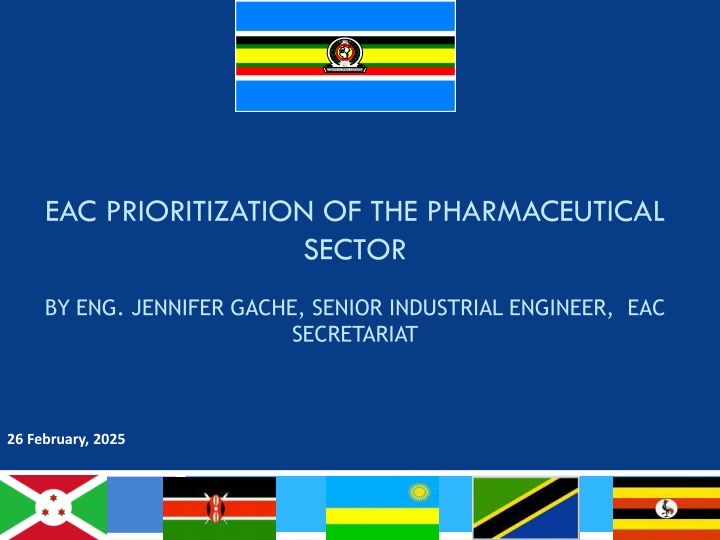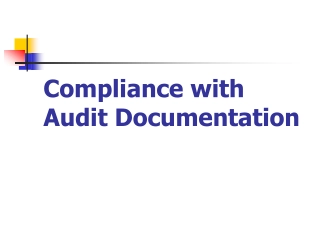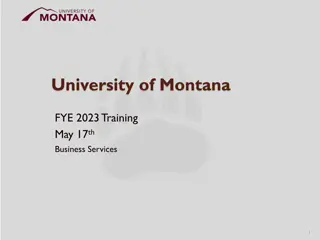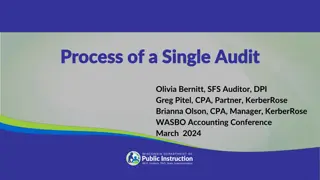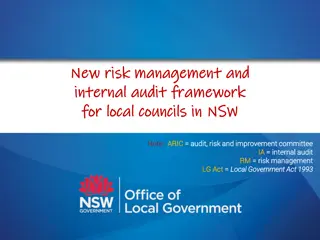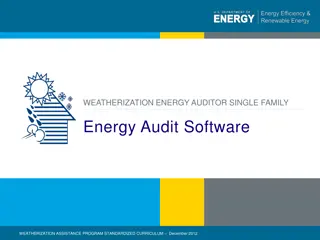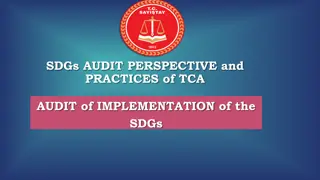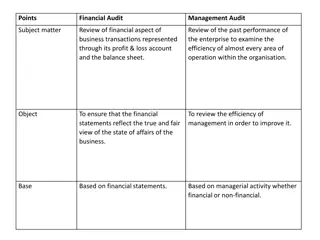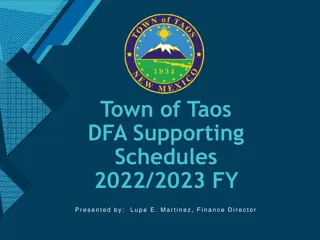Town of Taos FYE 2019 Financial Statement Audit
Presentation of the FYE 2019 financial statement audit conducted by Cordova CPAs LLC, highlighting communication with governance, auditors' opinion, timeline of events, significant estimates, and reports on internal control and compliance. The audit was performed in accordance with GAAS and GAGAS, ensuring the fairness and accuracy of the financial statements.
Download Presentation

Please find below an Image/Link to download the presentation.
The content on the website is provided AS IS for your information and personal use only. It may not be sold, licensed, or shared on other websites without obtaining consent from the author.If you encounter any issues during the download, it is possible that the publisher has removed the file from their server.
You are allowed to download the files provided on this website for personal or commercial use, subject to the condition that they are used lawfully. All files are the property of their respective owners.
The content on the website is provided AS IS for your information and personal use only. It may not be sold, licensed, or shared on other websites without obtaining consent from the author.
E N D
Presentation Transcript
EAC PRIORITIZATION OF THE PHARMACEUTICAL SECTOR BY ENG. JENNIFER GACHE, SENIOR INDUSTRIAL ENGINEER, EAC SECRETARIAT 26 February, 2025 Flag of Burundi Tazama picha kwenye ukubwa wa awali. http://www.mapsofworld.com/flags/tanzania-flag.html Tazama picha kwenye ukubwa wa awali. http://www.unitedplanet.org/volunteer-in-uganda-long-term/
OUTLINE Introduction Background on EAC Industrialization Policy Progress Council Directives on the pharmaceutical sector
Introduction to the Region: EAC-COMESA- SADC Free Trade Area Presents market of 26 countries; an integrated A combined population of almost 600 million people (57% of population), that is, half of the African Union (AU) in terms of membership; the AU Total Product of about US$ 1 trillion (58% continent s GDP). Gross Domestic of the
WHY EAC INDUSTRIALIZATION ? Low per Capita Income Unemploym ent High Demand for Social Support EAC DEVELOPMENT VISION Reduced interest for Local and FDI in manufacturing etc Less Funding for Development Programs Poor infrastructure and support for investment
Background on EAC Industrialization Policy Theme: Structural Transformation of the Manufacturing Sector through High Value Addition and Diversification. The strategy focuses on the Manufacturing sector in the region. See UN(ISIC) Codes, Rev.3.1 Based on comparative and competitive advantage. Emphasis strategic regional value chains with long backward and forward linkages with the rest of the economy thereby increasing employment and quality of jobs Recognizes that access to high quality education, R&D and Innovation is vital for strengthening the productivity of the labour force and accelerating growth Market led-Private Sector Approach
Specific Targets of the Industrialization Strategy Objective Present 2011 Target 2032 Diversifying the manufacturing base and raising local value added Estimated value of To at least 40% 8.62% Manufacturing contribution to the regional GDP industry s Currently at an average of 9.7% To an average of 25% 6 Manufacturing based employment 456,000 About 2.3 million GDP per capita $ 558 $ 1,300 Transforming medium enterprises into viable and sustainable business Increasing manufactured added per capita micro small and Contribution 20% Contribute 50 % of manufacturing GDP value $ 50 $ 258 Strengthens Institutional capabilities to deliver support services Strengthen Research, Development Technology and Innovation
Background: EAC industrialization policy and strategy identifies sectors to be developed to achieve a number of regional policy goals 7 Local Value Addition (40 %) Trade expansion- 60% exports & 25% intra- EAC trade SMEs-50% GDP Contribution Increasing manufacturing share of GDP to 25 % Increase employment opportunities to 2.3 million
Short-listing of Regional Industries Assessment Framework 8 Source: UNIDO; 2011
Industries with High Growth Potential in the Region based on Assessment Framework S.no. Industries Total Attractiveness Total Strategic Feasibility 9 Weightage Agro Processing - Veg Oil, Fruits, Beverages, Dairy, Meat, Nuts, Plantation produce, Grain milling 2 Fertilisers and agrochemicals 3 Pharmaceutical Industry - Bulk and retail 4 Petrochemicals and Gas processing Iron, Steel and other metals and their products tubes, bars, rods, rolls, wires, pipes, mesh Energy - Bio, Ethanol, Solar, Geo thermal, Hydro-electric, Thermal etc. 7 Agro machinery 8 Machine tools and spares 9 Basic medical equipment 10 Transformers and electrical equipment Textiles - Cotton, Silk, Linen Spinning, Weaving and Garments 12 Packaging Industry & Sacks 13 Plastic products 14 Electronic and computer assembly 15 Cement 16 Sheet Glass and ceramics 17 Leather 18 Dyes and chemicals 19 Soaps and Detergents Automotives - cars, buses and tractor assembly and spares 1 8.20 7.05 6.80 6.75 6.80 6.20 4.99 4.74 5 6.45 4.69 6 6.40 6.30 6.05 6.00 5.85 6.23 4.39 4.39 4.64 4.34 11 5.80 5.65 5.65 5.65 5.45 5.40 5.30 5.00 4.90 5.69 5.24 4.89 4.09 5.74 4.94 5.54 4.89 4.94 20 4.50 4.34
Attractiveness and Strategic Feasibility of a Targeted Industry (Using an Assessment Framework) Six strategic Industries prioritised: 1. Agro-processing 2. Fertilisers and agrochemicals 3. Pharmaceuticals; 4. Petro-chemicals and gas 5. Iron-ore and other mineral processing; 6. Energy and bio-fuels.
Progress The EAC Industrialization Policy and Strategy was approved in November 2011. The Action Plan for the Implementation of the EAC Industrialization Policy and Strategy was approved by the Sectoral Council on Trade, Industry, Finance and Investment (SCTIFI), during its meeting held on 2ndNovember 2012. EAC Regional Pharmaceutical Manufacturing Plan of Action (EAC-RPMPOA), 2012-2016 was approved in 2011; Implementation of EACRPMPOA is part of implementation of the EAC Industrialization Policy and Strategy
Council Directives on Implementation of EACRPMPOA-Health The Sectoral Council of Health in a meeting held on 17th April 2014(Report Ref. EAC/SR 167/2013) in Zanzibar, United Republic of Tanzania (URT): approved the Terms of Reference for establishment of a regional steering committee and directed the Secretariat to establish a joint working group between the Health and Industry to address the issue of development of the pharmaceutical industry in the region. The joint working group has been established at a regional level. Noted that implementation of the plan will be coordinated by the department responsible for industrialization.
Council Directives on Implementation of EACRPMPOA-Industry The Sectorial Committee on Industrialization in the meeting held on 20thto 22ndAugust 2014 (Report Ref. EAC/SCI/002/2014): called on the establishment of national steering committees comprising the industry and health sectors to fast track the implementation of the Plan of Action. The meeting agreed that the responsibility of coordinating the implementation spearheaded by the Industrialization who would establish a Focal Point for implementation of the Action Plan and a Champion to drive the process. would be for Ministry responsible
Sectoral Council on Trade, Industry, Finance and Investment (May 2016)directives on the sector called for: Meetings between health and industry to coordinate implementation of the (i) Action Plan and also address issues of the development of Pharmaceutical Industry in the Region particularly enhancement of local production of medicines ; (ii) Review of EAC Pharmaceutical Manufacturing Plan of Action); (iii) Support to EACRPMPOA National Coordination Committees in Partner States to prepare Action Plans; (iv) Continued support to the development of Trade Related Aspects of Intellectual Property Rights (TRIPS) policy on the use of public health related TRIPS flexibilities; (v) Trainings and Sensitization on domestication of the TRIPS Policy; done in- conjunction with UNCTAD; WTO; WIPO and WHO; and (vi) Support to promotion of a policy brief on an Incentive Framework for the promoting local manufacturing in corporation with the Federation of East African Pharmaceutical Manufacturers (FEAPM);
Sectoral Council on Trade, Industry, Finance and Investment directives on the sector: (a) Noted that Kenya is already in the process of implementing a Good Manufacturing Practice (GMP) road map and that the initiative is also being undertaken at the continental level spearheaded by the African Union; thus need for a regional programme; (b) Approved the Concept Noted on GMP Roadmap, recognized the requirement of financial resources to undertake the GMP exercise as the exercise is expensive and time consuming; and noted the; need to look into public private arrangements in implementing the road map ; (c) Noted that the EAC had adopted guidelines on GMP regulations prepared by the Medicines Regulation Harmonization project and there was need to support the industry to comply with this standards; (d) Noted need for increasing local production of safe, efficacious and quality medicines as a priority for the region and need to include this in the terms of reference for the new EACRPMPOA; It was also proposed that programmes should be focused on enabling the manufacturers to increase production; in compliance with GPM regulations; standards and quality assurance; other programmes could focus on branding, pricing and tripartite arrangements bringing together doctors, manufactures and chemists
Thank you 16 Jennifer Gache, Senior Industrial Engineer, (gache@eachq.org)
